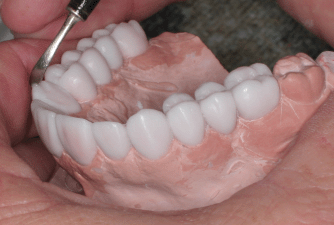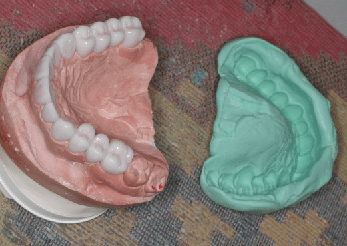Complex cosmetic dentistry, especially the rehabilitation of worn teeth, utilizes diagnostic wax-ups as the most important step for a smile makeover and its functional and mechanical aspects. It is an indispensible tool for full-mouth reconstructions.
However, even the most conservative approach with porcelain veneers is much more predictable when utilizing a diagnostic wax-up together with transfer matrices for the fabrication of the temporary veneers in the patient's mouth. In addition, since the final contour of a textbook smile design is knows, reduction guides based on that desired contour allow the cosmetic dentist to gauge the required reduction of tooth structure while remaining as conservative as possible. Hence, a diagnostic wax-up facilitates minimally invasive dentistry.
Diagnostic wax-ups are used for many reasons:
- to diagnose potential problems
- to identify the solutions
- to design tooth shapes and arch forms before touching a tooth
- to diagnose if and how worn teeth can be rebuilt
- to explain to the patient what can be achieved - to communicate and share goals with the patient
- to fabricate a matrix from the wax-up that will be used as a mold for the next step of comprehensive cosmetic dentistry: the provisional restorations
Before designing a diagnostic wax-up, the following questions need to be answered:
- What doesn't the patient like about his current smile?
- Are there any bite problems or grinding habits?
- Does the gum line need to be altered?
- Does the dental midline coincide with the facial midline?
- Is the buccal corridor full or collapsed?
- How many teeth need to be included?
- What is the physiological bite relationship?
It is important to find every problem when examining a patient. Signs, which patients often fail to recognize (because they do not bother them, YET!), almost always precede symptoms. So it is not enough to rely on a patient expressing what he or she wants. Patients also need to be informed about every aspect of their oral health and the implications of ignoring potential problems.
The diagnostic wax-up helps determine if a case is easily resolved or extremely complicated. It helps to determine if other adjunctive treatments, such as orthodontics or oral surgery, will be necessary. All the information of a diagnostic wax-up is obtained without having to cut a tooth and will help the patient to make an educated choice about whether or not he or she is willing to go through the time and expense of the treatment. It is an excellent communication tool.
In the hands of a talented dentist, the diagnostic wax-up can be incorporated into a smile image of a patient using Photoshop. It gives the patient a good idea how a particular wax-up design would look in the patient's face:


Temporary restorations are based on the diagnostic wax-up, which is transferred into the patients mouth via the matrices as shown above. A transfer of a textbook-level wax-up to provisionals in the patients mouth is the best 3D-simulation that can be created. The patient can wear them for some time to make sure that they feel comfortable. A few days after insertion of the provisionals the patient meets with Dr. Rabanus to either approve the general design or request aesthetic and functional adjustments. Once completed to the patient's satisfaction, another quick impression is taken of the approved provisionals and sent to the lab as a reference. At that point, the remaining aesthetic elements, such as shade, polychomaticity, incisal tranlucency, Halo effect, and other 3D-effects will be established.



